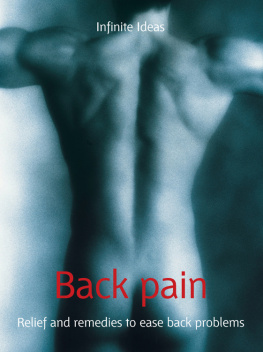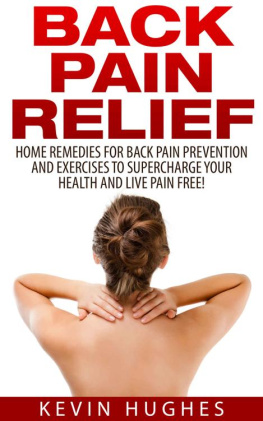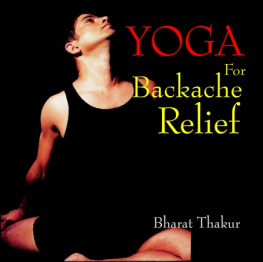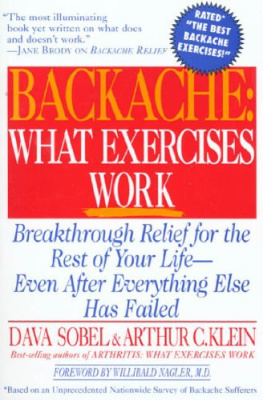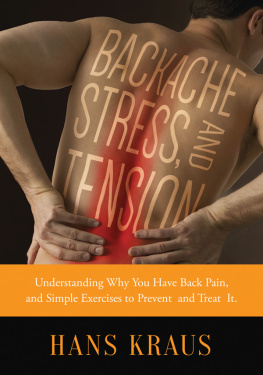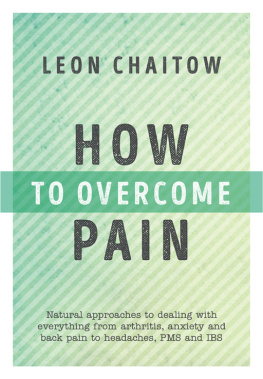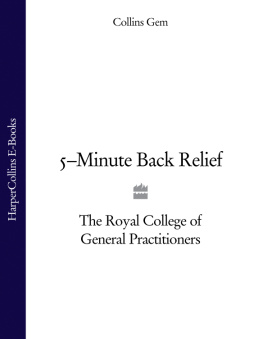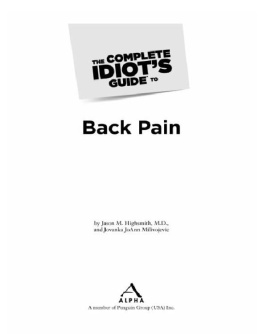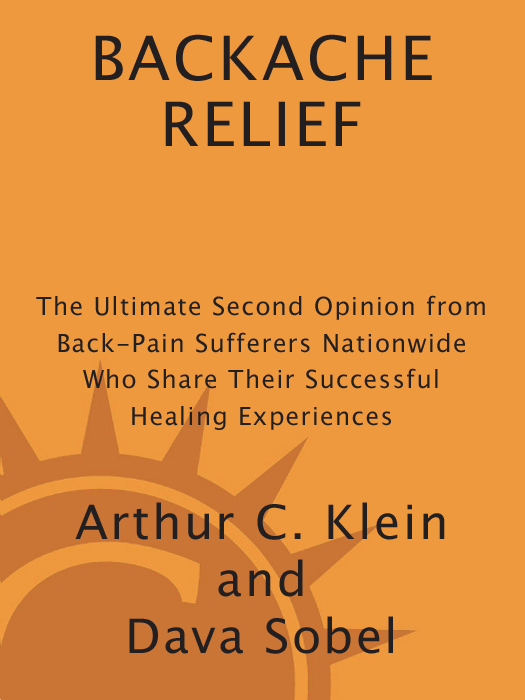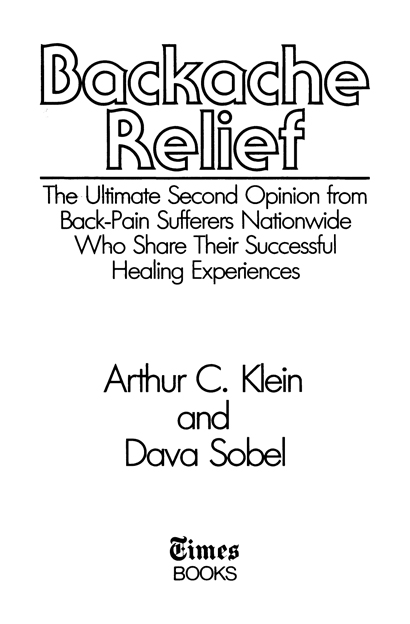Copyright 1985 by Arthur C. Klein and Dava Sobel
All rights reserved under International and Pan-American Copyright Conventions. Published in the United States by Times Books, a division of Random House, Inc., New York, and simultaneously in Canada by Random House of Canada Limited, Toronto.
Library of Congress Cataloging in Publication Data
Klein, Arthur C.
Backache relief.
1. Backache. I. Sobel, Dava. II. Title.
RD768.K56 1985 617.56 84-40424
eISBN: 978-0-307-82473-8
v3.1
For Zo Rachel Klein
Acknowledgments
Our thanks to Donna Danyluk, Millie Mascia, Page McBrier, and especially Evelyn Poitras for their help with the research on which this book is based and the preparation of the manuscript;
To our literary agent, Max Gartenberg, who helped define the scope and structure of the book;
To Miriam Fisher, our first survey participant, for her many contributions to the background research;
To Frank Anello for his support and inspiration;
And to Jonathan B. Segal of Times Books for his advice, encouragement, and enthusiasm.
Foreword
There was a time in my own life when I would have looked down my nose at anyone who couldnt manage back pain. Low back pain ran in my family and I had my first acute episode of muscle spasms at 18. After being told that rest was the only answer, I proceeded to treat myself. I bought a bed board and a firm mattress. I found a good writers chairone that supported my lower back and raised my knees higher than my hips. After graduating from college I joined a gym. I jogged every morning and took time off every afternoon to lie on the floor and listen to music. Back exercises? No one performed them more faithfully than Ithirty minutes a day, up to and including the day a few years ago that I wound up in bed looking like a pretzel and feeling a lot worse.
Six months later, I still wasnt on top of the world, in spite of having seen an internist, two orthopedists, a neurologist, a doctor of physical medicine, a chiropractor, and a physical therapist.
Eventually, I found the help I needed. But had I known then what I know now, I would have saved myself an awful lot of anguish, including the almost unbearable emotional pain of not being able to pick up, hold, and cuddle my newborn daughter.
I dont mention all this because the answers I found for myself will solve your problems: I needed ankle surgery and treatment of a congenital neuromuscular disorder to correct the underlying cause of my back pain. I mention my own experiences in trying to get well because they motivated me to carry out the research for this book. I simply couldnt get the same answer twice. And, many times, I couldnt get any answers. Small wonder. Owing to the thinness of research in the field, even back practitioners themselves dont know how well or poorly most treatments work. The common cold is taken more seriously. However, I believe that will change now. And I expect, hope, and pray that this book will be the start of the end of your back problem.
Arthur C. Klein
August 1984
A Note About the Research
The information, ratings, and advice in this book are based on the results of the most extensive survey of back sufferers ever undertaken. Individuals volunteered to participate in the survey by responding to public notices and advertisements in the following publications: American Business, Columbia Journalism Review, East-West, Family Weekly, In These Times, Moneysworth, Mother Jones, New Era, New York magazine, The New York Times, Prevention, and Saturday Review. In addition, some participants referred us to other back sufferers, who became participants.
Ninety-three of the total 492 participants responded by telephone. We interviewed each of these for an average of fifty-five minutes. The remaining participants inquired by mail and were sent a questionnaire. When we received a completed questionnaire, we followed up by telephone whenever necessary to expand or clarify a particular point of information.
Nearly 40 percent of individuals surveyed were readers of Family Weekly. This magazine is distributed in more than 200 medium-sized American cities, and the demographics of its readers closely match those of the general public.
Survey participants represent every stratum of American society, from the wealthy and famous to those who can no longer afford medical treatment. Arthur Ochs Sulzberger, publisher of The New York Times, filled out a questionnaire. John Davidson, goalie for the New York Rangers, phoned in his response after a chymopapain injection for a herniated disc. A weightlifting champion and a Pulitzer Prize-winning author also told us about their back problems. Health-care specialistsincluding medical technicians, dentists, chiropractic students, nurses, psychotherapists, massage therapists, marriage counselors, and alcoholism counselorstold about their ups and downs with back pain. Farmers and forest rangers, teachers and students shared their experiences. So did a federal labor arbitrator, a concert pianist, housewives, truck drivers, secretaries, professors, marathon runners, construction workers, salespeople, entrepreneurs, and prisoners. The youngest participant was a 10-year-old girl whose mother helped her fill out the questionnaire. The oldest participant was a 90-year-old woman who had just encountered back pain for the first time and who rid herself of her pain by taking her doctors advice to walk one mile every day.
At least 55 percent of the participants were female and 44 percent were male; one percent chose not to answer the question about sex. The vast majority of individuals were under age 50. Persons 18 and younger constituted one percent of the sample; 19 to 29, 28 percent; 30 to 49, 44 percent; 50 to 64, 18 percent; and 65 and older, 7 percent. These findings concur with available research about the sex and age of back sufferers.
All participants, whether orally or in writing, answered questions contained in a two-page questionnaire. Topics included types of practitioners seen, diagnosis from each practitioner, treatments and advice received, evaluation of each practitioner and treatment, exercise (frequency and source of instruction), emotional stress (its role in back pain and the practitioners approach to it), tips for back sufferers, and personal data (optional).
Two years passed from the time the first public notice appeared until the results of this survey were tabulated. When the number of participants reached 100, significant trends were already apparent for the most widely seen practitionersorthopedists, chiropractors, general practitioners, physical therapists, and osteopaths. At 200, the reasons behind these trends were clear, and more than twenty-five different kinds of health-care specialists and thirty-five different kinds of treatments had been reported. However, these could not be adequately evaluated. At 400, we had enough data to appraise virtually every kind of practitioner and treatment available to back sufferers.
Why, then, was the final count 492? Because the authors had a whim to have participants from every one of the fifty states.
So, thank you Laura L. of Alaska for allowing us to conclude this research on a happy note.
CONTENTS
PART ONE
An Introduction


